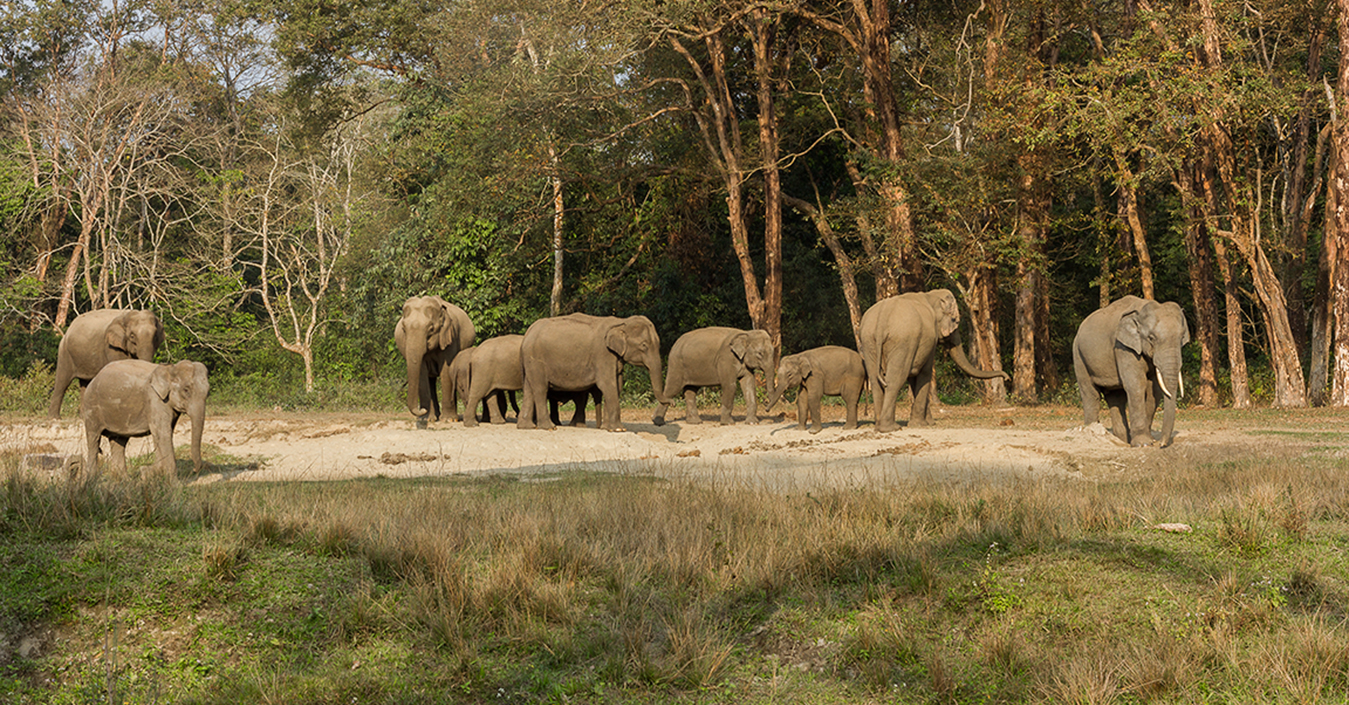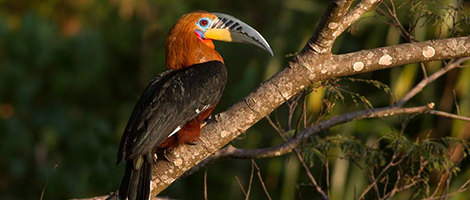
West Bengal

West Bengal

West Bengal is an eastern state of India that is blessed with amazing extremes. Stretching from the Himalayas through the Gangetic plains to the Bay of Bengal over the course of about 480+ km, this state displays almost all the geophysical features and its associated biodiversity that the Indian subcontinent can boast of. The northernmost district of Darjeeling is situated in the laps of the Himalayas, followed by the sub-montane terai region which supports a huge diversity of life forms, the western districts feature a semi-arid region of red lateritic soil with dry flanks of Chhotanagpur plateau, low hills, and sal-segun forests, the eastern districts represent vast riverine flood plains on both sides of the river Bhagirathi and its northern and western tributaries and in the southernmost part, the Bay of Bengal is the deltaic regions of Sundarban mangroves and coastal part of Midnapur.
Sundarban Tiger Reserve - This is the only mangrove forest where tigers can be found. Open throughout the year, this forest is visited only by means of a motorized boat. Apart from the tigers, this forest has elusive lesser cats like Fishing Cats, Leopard Cats, Jungle Cats; massive Saltwater Crcocdiles, Irrawaddy Dolphins, Asian Small-clawed Otters, King Cobra, etc. Sundarban is also a heaven for birdwatchers and is home to a variety of Kingfishers like Brown-winged, Black-capped, Collared, Ruddy, Common, White-throated, Pied, and Stork-billed. Buffy Fish Owl can be seen only in Sundarban and nowhere else in the entire Indian subcontinent. Changeable Hawk Eagle dark morph is another rarity from the region. Mangrove Pitta and Mangrove Whistler are the other rarities. Mudskippers, various crabs, and jellyfish are the other wildlife attractions.
Himalayas - The tiniest part of north Bengal holds six major national parks and Tiger Reserves. This area is home to Red Panda, Bengal Slow Loris, Great Indian Rhinoceros, Bengal Tiger, Asiatic Golden Cat, and Clouded Leopard amongst the rare and endangered mammalian fauna. Birds like the Great Hornbill, Rufous-necked Hornbill, Satyr Tragopan, Ward's Trogon, Beautiful Nuthatch, and Red Crossbill to name a few that dwell in this part of mountainous districts. A list of birds would consist of five species of Scimitar Babblers, Sixteen Species of Laughingthrushes, and Nine species of Phasnidae - from these three examples get an idea of how biodiversity rich the area is. In short, it is home to Six Hundred avian species. And here, as one covers every 30 kilometers of distance by driving - the landscape and forest type change a lot and so as the biodiversity and birds species. Places like - Neora Valley National Parl, Mahananda Wildlife Sanctuary, Senchal Wildlife Sanctuary, Buxa Tiger Reserve, Jaldapara National Park, and Gorumara National Park are the major wildlife destination in this squeezed area.
Birding destinations in Kolkata and vicinity:
Rabindra Sarobar - Kolkata as a city is one of the most biodiverse places in India and Rabindra Sarovar comes at the top of the list. From Asian Stubtail to Small Niltava in winter and from Violet Cuckoo to Indian Pitta; this small patch of 0.3 sq km of the area is a wonderland for the Calcuttan birdwatchers. Indian Paradise Flycatcher, Crow-billed Drongo, and a few species of Barbets and Orioles are always a delight to see. In the waterbody, all three types of Cormorants from the Indian subcontinent can be seen. Apart from that, this place has a resident population of Painted Stork (Near Threatened); where they breed and raise the chicks. All of these activities can be experienced far away from a distance. Visit for a while in the morning or afternoon session, if you are in Kolkata.
Chintamani Kar Bird Sanctuary - Like Rabindra Sarovar, this is also a woodland area and home to Brown Fish Owl, Indian Scops Owl, Large-tailed Nightjar, Asian Emerald Dove, Scarlet Minivet, Asian Paradise Flycatcher, Indian Pitta, and a lot of tiny tots that forage on the upper canopy. One can spend an entire day here, as every now and then some activities are always there. Whatever might be the season, Ckintamani Kar Bird Sanctuary or CKBS can be visited any time of the year.
Rajarhat - Baruipur - Dankuni - These are some vast expanses of grassland and wetland in the city fringes. Rajarhat being in the easternmost part, was once contiguous with Baruipur. Each of these grasslands has some star birds from the area. King Quails, Barred Button Quails, some species of Rails and Crakes e.g. Brown-cheeked Rail, Baillon's Crake, Ruddy-breasted Crake, Slaty-legged Crake, etc., Snipes, some grassland Warblers like - Lanceolated Warbler, Pallas's Grasshopper Warbler, Paddyfield Warbler, Baikal Bush Warbler, Spotted Bush Warbler, etc., and Chats are residents and winter visitors of these grasslands.
Shibpur Botanical Garden - One of the best-managed habitats for the birds of south Bengal is Shibpur Botanical Garden. Since this is a botanical garden, thus all the local plant species are kept in. The birds which are very commonly found here are Indian Paradise Flycatcher, Pale-billed Flowerpecker, Common Hill Myna, Alexandrine Parakeet, Rose-ringed Parakeet, Indian Golden Oriole, Black-hooded Oriole, Blue-throated Barbet, Yellow-footed Green Pigeon, Crow-billed Drongo, Large Woodshrike, etc. Apart from the woodland species, there are grassy meadows as well as foraging places for larks and pipits. The adjoining water bodies inside the park are also home to Cormorants, Jacanas, KIngfishers, Waterhens, Moorhens, Swamphens, and several species of Rails and Crakes. A full-day visit is at least required to cover this place thoroughly.
Wildlife destinations in the rest of West Bengal:
Henry Island & Fresergaunje - These two adjacent areas are one of the majorly visited coastal areas in South Bengal. Different species of Gulls, Terns, Sandpipers, Shanks, and Stints winter here in shallows to feed on marine substrates. The average arrival time for the wintering birds starts in late November and they stay till the middle of March or some overstays till April. In peak, during the months of January and February, one can expect to see 60 different species of waders over here. And if someone is fascinated by the breeding plumages, then a short visit in the 2nd or third week of April would show up colorful waders lurking on the beach. The month of May faces the rough sea wind in the Bay of Bengal, and sporadic sightings of pelagic species like Skuas, Boobies, Noddies, Shearwaters, and Petrels can be expected during this time.
Central Bengal - Gangetic Flood plains and Oxbow lakes of Nadia, Murshidabad, and Maldaha districts form a wonderful aquatic complex. Mostly during the migration stopovers, these sites are used for all the waders found in coastal areas and those going back up to high-altitude pastures of the Himalayas in summer. White-tailed Stonechat, Siberian Stonechat, Bluethroat, Siberian Rubythroat, Graceful Prinia, Ashy Prinia, and Yellow-bellied Prinia are majorly found grassland species in the area. Baikal Teal, Falcated Ducks, Scaups, Shelducks, etc. use this area as a stopover site during mean migration periods.
Purulia - This is the reminiscence of the Chota-Nagpur Plateau; also known as "Rard Bengal" as the easternmost extension of the plateau. This arid scrub forest is very dry and deciduous and mostly covered by rocky outcrops. Rock Eagle Owl, Tawny-bellied Babbler, Jungle Bush Quail, Savnna NIghtjar, Indian NIghtjar, Barred Button Quail, Black Francolin, Indian Cursor, Sirkeer Malkoha, etc. are some of the target birds for the birdwatchers'. Apart from that, this part hosts a lot of rare and endangered mammalian fauna as well like Indian Hare, Indian Wolf, Striped Hyena, Indian Pangolin, etc. to name a few. Two or three full-day in winter months are necessary to cover the target species.
